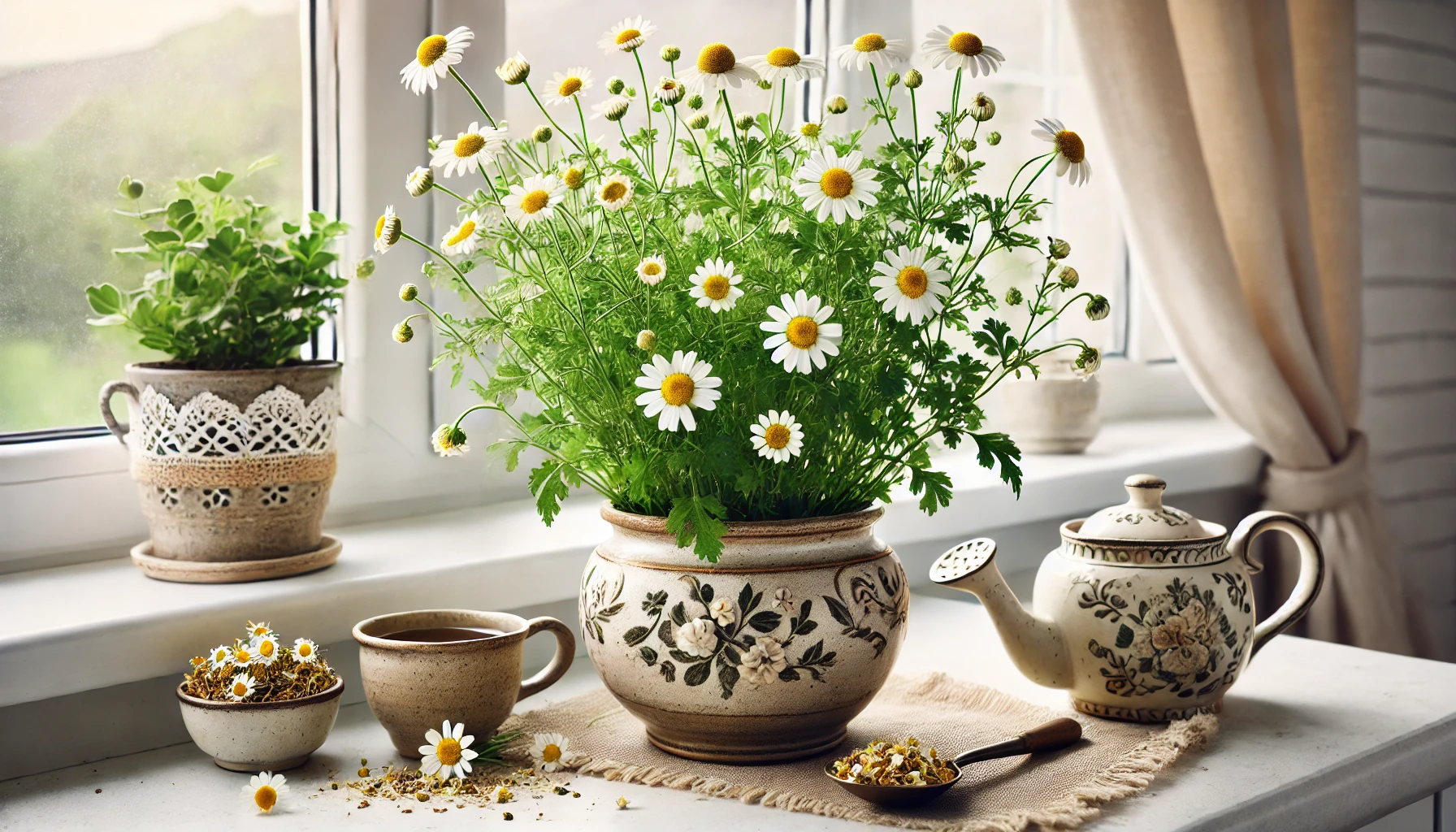Chamomile is a fragrant, easy-to-grow herb best known for its calming tea and medicinal benefits. Growing chamomile indoors allows you to enjoy its delicate flowers year-round while adding beauty and fragrance to your home. With the right care, chamomile thrives in containers and produces abundant blooms. This guide will take you through every step of growing and maintaining chamomile indoors.
1. Why Grow Chamomile Indoors?
Growing chamomile indoors has several advantages:
- Year-round harvesting – Enjoy fresh chamomile flowers anytime.
- Space-saving – Grows well in pots, making it ideal for apartments.
- Low maintenance – Requires minimal care once established.
- Health benefits – Used for teas, skincare, and natural remedies.
2. Choosing the Right Type of Chamomile
There are two main varieties of chamomile, but one is better suited for indoor growth:
- German Chamomile (Matricaria chamomilla) – An annual that grows tall (up to 24 inches), best for outdoor gardens.
- Roman Chamomile (Chamaemelum nobile) – A low-growing perennial with a milder flavor, perfect for indoor pots.
For indoor growing, Roman chamomile is the best choice due to its compact growth and continuous flowering.
3. Selecting the Right Pot and Soil
Choosing the Best Pot
- Use a 6–8 inch container with drainage holes to prevent root rot.
- Terracotta or ceramic pots help regulate moisture levels.
Best Soil for Chamomile
- Use a light, well-draining potting mix.
- Add perlite or sand to improve aeration.
- Avoid rich, heavy soils, as chamomile thrives in lean conditions.
4. Providing the Right Light Conditions
Chamomile loves bright, indirect sunlight.
- Place the pot in a south- or east-facing window where it gets 6–8 hours of sunlight daily.
- If natural light is insufficient, supplement with a full-spectrum LED grow light for at least 10–12 hours per day.
- Rotate the pot occasionally to ensure even light exposure.
5. Watering and Humidity Needs
Chamomile prefers slightly dry conditions over constant moisture.
- Water when the top inch of soil feels dry. Stick your finger in the soil to check before watering.
- Use the “soak and dry” method – water deeply, then let the soil dry completely before the next watering.
- Avoid overwatering, as chamomile roots are prone to rot.
- Chamomile tolerates low to moderate humidity, so misting is usually unnecessary.
6. Temperature and Air Circulation
- Keep the temperature between 60–75°F (16–24°C) for optimal growth.
- Avoid placing chamomile near cold drafts, heaters, or air conditioning vents.
- Ensure good air circulation to prevent mold or fungal growth.
7. Fertilizing for Healthy Growth
Chamomile does not require heavy feeding.
- Use a diluted organic fertilizer (such as compost tea or fish emulsion) once every 4–6 weeks.
- Avoid excessive nitrogen, as it can lead to excessive foliage growth at the expense of flowers.
8. Pruning and Harvesting Chamomile
Regular pruning encourages bushier growth and more flowers.
How to Prune Chamomile for Best Growth
- Trim stems once the plant reaches 4–6 inches to encourage branching.
- Remove yellowing or dead leaves to keep the plant healthy.
Harvesting Chamomile Flowers
- The best time to harvest is when flowers are fully open, but before petals droop.
- Use scissors to snip the flower heads, leaving a bit of stem attached.
- Dry flowers in a warm, well-ventilated area for later use in teas.
9. Common Problems and How to Fix Them
1. Yellowing Leaves
Cause: Overwatering or poor drainage.
Solution: Reduce watering and ensure the pot has proper drainage.
2. No Flowers
Cause: Not enough light or too much nitrogen.
Solution: Move to a sunnier spot and reduce fertilization.
3. Mold or Fungus on Soil
Cause: Poor air circulation or overwatering.
Solution: Improve airflow and let the soil dry between watering.
10. Propagating Chamomile for More Plants
Chamomile can be propagated by seeds or division.
How to Grow Chamomile from Seeds
- Sprinkle seeds over moist soil and lightly press them in.
- Keep the soil slightly damp until seedlings appear (7–14 days).
- Thin seedlings so they have 2–3 inches of space between them.
How to Propagate by Division
- Carefully remove the plant from its pot.
- Divide the root system into sections, ensuring each has stems and roots.
- Replant each section in a separate pot with fresh soil.
11. Companion Plants for Chamomile
If growing multiple herbs indoors, chamomile pairs well with:
- Basil – Similar light and watering needs.
- Lavender – Enhances fragrance and repels pests.
- Mint – Provides shade and helps control pests naturally.
Avoid planting chamomile near moisture-loving herbs like rosemary, as they have different watering needs.
12. Using Fresh and Dried Chamomile
Chamomile is known for its relaxing properties and is commonly used in:
- Tea – Steep dried flowers in hot water for a soothing drink.
- Skincare – Infuse chamomile into lotions or facial sprays for anti-inflammatory benefits.
- Aromatherapy – Dried chamomile can be placed in pillows for relaxation.
Final Thoughts
Growing chamomile indoors is a simple and rewarding process that provides fresh flowers for tea, aromatherapy, and herbal remedies. By following these care tips, you’ll have a thriving chamomile plant that enhances your home with beauty and fragrance.

